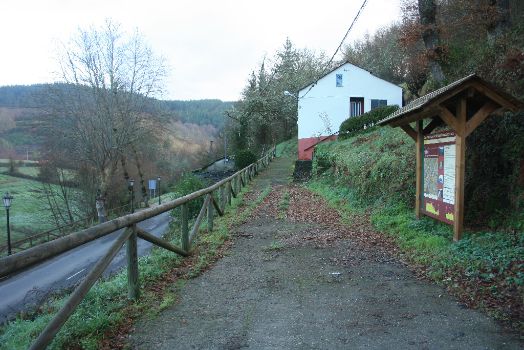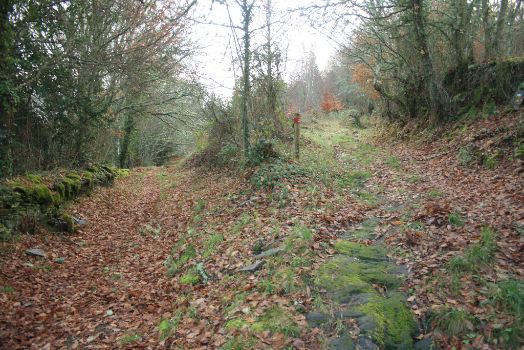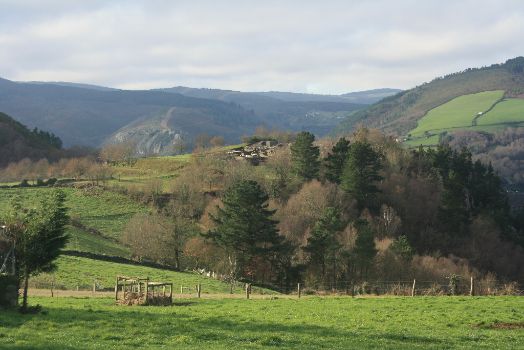Net of Natural
Trails

Stage 26: Grandas - Castro
Description
The world of fortified settlements
The Nature Trail makes its way through small villages that reveal the ancient history of this land, evidenced by numerous burial mounds and funerary chambers of ancient “castreña” settlers. Places like the fortified settlement, or “castro” as it is known, of Chao Samartín bear valuable witness to that period.
The Nature Trail begins in Grandas, capital of Grandas de Salime County, and heads west to the village of Castro, near which is Chao Samartín, a Celt fortified settlement built in the eighth century B.C. It is most valuable as evidence of the existence of prehistoric settlements in northwest Spain, some of which survived the occupation of the Romans.

The county's history has its roots in the Middle Ages and the original Way of St. James. The last Asturian section of the former pilgrimage route to Santiago traversed this municipality, from east to west, into Galicia through Alto del Acebo.
Starting at Grandas, the route follows a path on the left of the start-end panel, located on the left side of the AS-14, as one approaches Grandas. Immediately after, the Trail turns to the right, leaving the trail end of the previous section to the left.
The route continues along a stone and dirt path, through pines and oaks, until it begins to widen and turns into a paved access road. At the beginning, the track winds through pine forests. Special attention should be paid to the directional signs so as not to stray from the route, which continues through meadows and pastures, with beautiful views of the River Navia.

Further on, the route comes upon the road, and immediately after leaving behind the village of Robledo, turns right along a dirt track until an intersection where there are two possible paths. The route to the left runs along a narrow path, through meadows and hardwood groves, to the village of Valdedo. The route to the right continues along a dirt track to join a road that heads down to the village of Cereijeira, where it turns left through a tunnel under the main road to arrive also at Valdedo.
From this village, the route continues along a gravel track, leaving the village of San Julián to the right, to reach the village of Castro, the final destination of this section. In Castro, the path continues ahead to Chao Samartín.
Sites of interest
Profile

Highlights
Further information
Way of St. James: the Original Route
The Original Way of Saint James starts in Grandas, on Carmen Street, and heads south to La Farrapa. After a certain distance, the route turns right, opposite the Xuntacasa, to continue straight ahead to Cerexeira. Further on, it runs parallel to the road, until it turns right towards Malneira.
Leaving the chapel of Esperanza de Malneira behind, the Jacobean route continues southwest to the town of Castro. Straight ahead, the route heads to Padraira, whose houses appear on the left, below the Trail. Further on, is the shrine of San Lázaro de Padraira. Keeping straight ahead, without straying onto the paths that appear along the way, the route reaches the road near Xestoselo.
The Trail continues along the AS-28 (Grandas de Salime-Alto del Acebo) to Peñafonte. It heads up to the village along a side-track to the right and continues south through the village. Next to the last house, a path heads towards a mountain pass, skirting around the slopes of Mount Zarro, where it comes upon a road. Immediately after, it turns onto a path to the left, which climbs to the right towards Monte de La Curiscada or Cuia, where a now-defunct hospital for pilgrims stood. It is also possible to climb to this point via Bustelo del Camino.
At the summit, the Jacobean route descends sharply to the right, then continues in moderate descent towards the firebreak that marks the boundary with Galicia, along which the climb continues for another 50 metres. The route then heads to the right, in a steady descent towards Alto del Acebo, the natural point of entry into Galicia.
Chao Samartín
Very close to the village of Castro is Chao Samartín, a Celt fortified settlement whose construction began in the eighth century B.C., during the Late Bronze Age. It is situated atop the site, in a narrow strip of land about 30 m wide and 80 m long, protected by a wall, moat and palisade.
The settlement was never used for residential purposes, but rather for cultural or sacred purposes, like a Greek temenos (sacred enclosure dedicated to a god and marked off from common use). The cranial vault of a young woman was found in a “cista” (small individual grave) dug into the ground near the gateway to the fort.
During the Iron Age (5th century B.C. to 1st century A.D.), the settlement was expanded across the promontory, protected by a modular wall similar to other forts found in central and western Asturias. It had a large oblong barrack hut and a thermal building or “castro”-style sauna, with steam baths situated under the apse.
During the Roman occupation of the 1st and 2nd centuries A.D., the densely populated settlement became the administrative centre at the service of the economic interests of the gold mining operations in the area (Pedras Apañadas, Valabilleiro, etc.).
Materials imported from southern France, Zamora, Ebro Valley and La Meseta have been found at the site. The houses were decorated with Roman-style paintings, the streets and squares were paved and the settlement had a proper sewage system.
A Roman domus, built in the 1st century A.D. has been found on the north slope. It has a central courtyard surrounded by a peristyle of columns, and the wall is plain with remains of stucco ornaments. According to the information available, the settlement was probably abandoned in the mid-second century A.D., following a devastating earthquake.
The settlement was last used as a medieval necropolis from the eighth to the tenth century A.D. It consists of more than thirty burial mounds with a slab headstone resembling a stela.
Chao Samartín Castro Museum
Close to the ruins of the settlement is the Chao Samartín Castro Museum. It traces the origin and evolution of fortified settlements in western Asturias, based on decades of archaeological findings carried out under the Cuenca del Navia-Eo Archaeological Programme. Most of the pieces shown in the permanent exhibition were found in Chao Samartín. However, there are also other objects from various regional sites, including Os Castros de Taramundi and Monte Castrelo de Pelou.





